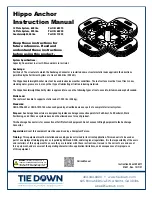
Safety Products Division
605 Stonehill Drive SW, Atlanta, Georgia 30336
404-344-0000 • www.tiedown.com
ISO 9001:2015 Certification
Intellectual Property of TIE DOWN Inc. ©2020 TIE DOWN, Inc.
Instruction #08371 (E1831 Rev. 10/7/21)
Hippo Roof Anchor
Safety Information - Do not alter equipment. Do not misuse equipment.
Workplace conditions, including, but not limited to, flame, corrosive chemicals, electrical shock, sharp objects, machinery, abrasive
substances, weather conditions, and uneven surfaces, must be assessed by a competent person before fall protection equipment is
selected.
The analysis of the workplace must anticipate where workers will be performing their duties, the routes they will take to reach their
work, and the potential and existing fall hazards they may be exposed to. Fall protection equipment must be chosen by a competent
person. Selections must account for all potential hazardous workplace conditions. All fall protection equipment should be purchased
new and in an unused condition.
Fall protection systems must be designed in a manner compliant with all federal, state, and safety regulations. Forces applied to
anchors must be calculated by a competent person. Unless explicitly stated otherwise, the maximum allowable free fall distance for
lanyards must not exceed 6’. No free fall allowed for non-LE SRL’s. Class A SRL’s must arrest falls within 24”; Class B SRL’s must arrest
falls within 54”.
Harnesses and connectors selected must be compliant with manufacturer’s instructions, and must be of compatible size and
configuration. Snap hooks, carabiners, and other connectors must be selected and applied in a compatible fashion. All risk of
disengagement must be eliminated. All snap hooks and carabiners must be self-locking and self-closing, and must never be connected
to each other.
A pre-planned rescue procedure in the case of a fall is required. The rescue plan must be project-specific. The rescue plan must allow
for employees to rescue themselves, or provide an alternative means for their prompt rescue. Store rescue equipment in an easily
accessible and clearly marked area.
Training of Authorized Persons to correctly erect, disassemble, inspect, maintain, store, and use equipment must be provided by a
Competent Person. Training must include the ability to recognize fall hazards, minimize the likelihood of fall hazards, and the correct
use of personal fall arrest systems.
Equipment subjected to forces of fall arrest must immediately be removed from use. Age, fitness, and health conditions can seriously
affect the worker should a fall occur. Consult a doctor if there is any reason to doubt a user’s ability to withstand and safely absorb fall
arrest forces or perform set-up of equipment. Pregnant women and minors must not use this equipment. Physical harm may still occur
even if fall safety equipment functions correctly. Sustained post-fall suspension may result in serious injury or death. Use trauma relief
straps to reduce the effects of suspension trauma.
Inspection
• Check the counterweights for excessive dents or deformations. Check the base counterweights for delamination.
• Inspect the system for physical damage. Look carefully for any signs of cracks, dents or deformities in the metal.
• Inspect the system for severe corrosion.
• Ensure the condition of the roof will support the The Hippo Counterweight Anchor System loads.
• Ensure that the bolts and nuts are in good condition and tightened securely. Use of tools may result in over-tightening,
possibly damaging the system. Hardware in poor condition should be replaced.
• Rooftop Anchor - Visually inspect the Anchor for signs of deployment. If the Hippo Counterweight Anchor has been
subjected to fall arrest forces or requires service and must not be used.


























